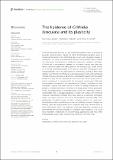Files in this item
The lipidome of Crithidia fasiculata and its plasticity
Item metadata
| dc.contributor.author | Cerone, Michela | |
| dc.contributor.author | Roberts, Matthew | |
| dc.contributor.author | Smith, Terry K | |
| dc.date.accessioned | 2022-11-24T17:30:13Z | |
| dc.date.available | 2022-11-24T17:30:13Z | |
| dc.date.issued | 2022-10-28 | |
| dc.identifier | 282291352 | |
| dc.identifier | 7bc22ae0-20b7-4a3b-94b1-f12cd668a51c | |
| dc.identifier | 36405970 | |
| dc.identifier | 85142299584 | |
| dc.identifier | 000886480200001 | |
| dc.identifier.citation | Cerone , M , Roberts , M & Smith , T K 2022 , ' The lipidome of Crithidia fasiculata and its plasticity ' , Frontiers in Cellular and Infection Microbiology , vol. 12 , 945750 . https://doi.org/10.3389/fcimb.2022.945750 | en |
| dc.identifier.issn | 2235-2988 | |
| dc.identifier.other | PubMedCentral: PMC9671073 | |
| dc.identifier.uri | https://hdl.handle.net/10023/26494 | |
| dc.description | Funding: We would like to thank the Engineering and Physical Sciences Research Council, University of St. Andrews, and the EPSRC Centre for Doctoral Training in Critical Resource Catalysis (CRITICAT) for financial support [Ph.D. studentship to MC; Grant code: EP/L016419/1]. | en |
| dc.description.abstract | Crithidia fasiculata belongs to the trypanosomatidae order of protozoan parasites, bearing close relation to other kinetoplastid parasites such as Trypanosoma brucei and Leishmania spp. As an early diverging lineage of eukaryotes, the study of kinetoplastid parasites has provided unique insights into alternative mechanisms to traditional eukaryotic metabolic pathways. Crithidia are a monogenetic parasite for mosquito species and have two distinct lifecycle stages both taking place in the mosquito gut. These consist of a motile choanomastigote form and an immotile amastigote form morphologically similar to amastigotes in Leishmania. Owing to their close relation to Leishmania, Crithidia are a growing research tool, with continuing interest in its use as a model organism for kinetoplastid research with the added benefit that they are non-pathogenic to humans and can be grown with no special equipment or requirements for biological containment. Although comparatively little research has taken place on Crithidia, similarities to other kinetoplast species has been shown in terms of energy metabolism and genetics. Crithidia also show similarities to kinetoplastids in their production of the monosaccharide D-arabinopyranose similar to Leishmania, which is incorporated into a lipoarabinogalactan a major cell surface GPI-anchored molecule. Additionally, Crithidia have been used as a eukaryotic expression system to express proteins from other kinetoplastids and potentially other eukaryotes including human proteins allowing various co- and post-translational protein modifications to the recombinant proteins. Despite the obvious usefulness and potential of this organism very little is known about its lipid metabolism. Here we describe a detailed lipidomic analyses and demonstrate the possible placidity of Crithidia’s lipid metabolis. This could have important implications for biotechnology approaches and how other kinetoplastids interact with, and scavenge nutrients from their hosts. | |
| dc.format.extent | 18 | |
| dc.format.extent | 8647090 | |
| dc.language.iso | eng | |
| dc.relation.ispartof | Frontiers in Cellular and Infection Microbiology | en |
| dc.subject | Kinetoplastid | en |
| dc.subject | Crithidia | en |
| dc.subject | Lipids | en |
| dc.subject | Fatty acids | en |
| dc.subject | Plasticity | en |
| dc.subject | Oils | en |
| dc.subject | Sugars | en |
| dc.subject | QD Chemistry | en |
| dc.subject | NDAS | en |
| dc.subject | MCC | en |
| dc.subject.lcc | QD | en |
| dc.title | The lipidome of Crithidia fasiculata and its plasticity | en |
| dc.type | Journal article | en |
| dc.contributor.sponsor | EPSRC | en |
| dc.contributor.institution | University of St Andrews. School of Biology | en |
| dc.contributor.institution | University of St Andrews. Sir James Mackenzie Institute for Early Diagnosis | en |
| dc.contributor.institution | University of St Andrews. Biomedical Sciences Research Complex | en |
| dc.identifier.doi | https://doi.org/10.3389/fcimb.2022.945750 | |
| dc.description.status | Peer reviewed | en |
| dc.identifier.grantnumber | EP/L016419/1 | en |
This item appears in the following Collection(s)
Items in the St Andrews Research Repository are protected by copyright, with all rights reserved, unless otherwise indicated.

